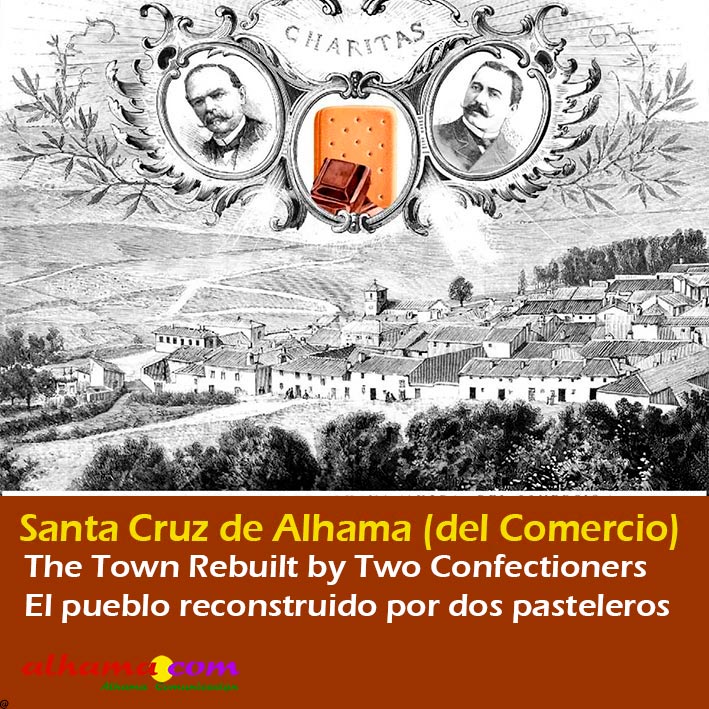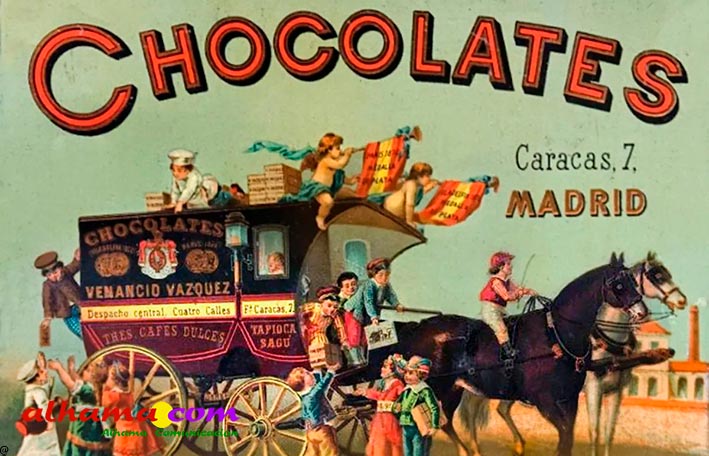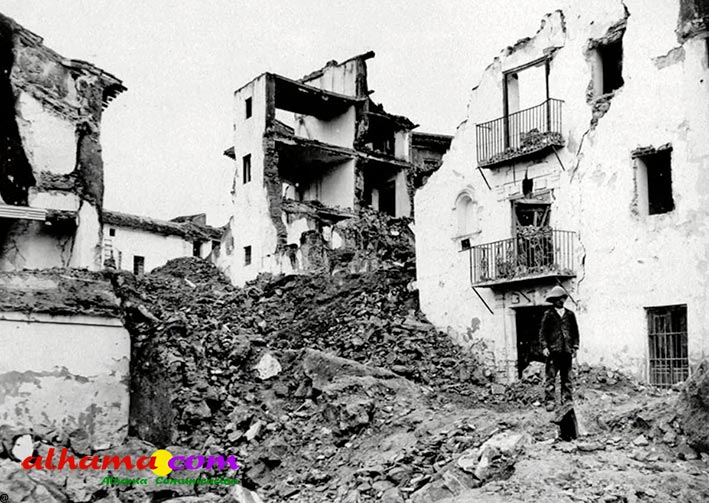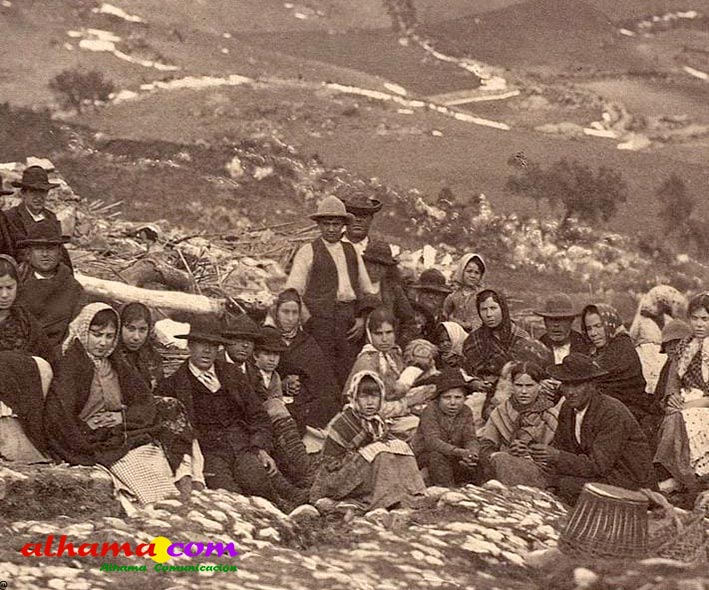
Santa Cruz de Alhama (Granada) changed its name in honor of the merchants who rebuilt it after the 1844 earthquake.
Hoy nos ha sorprendido encontramos en el digital TodoAlicante.es, este artículo sobre Santa Cruz del Comercio, relacionado con el terremoto de 1884, y más aún escrito en ingles, el cual hemos traducido. Igualmente también nos ha sorprendido con las fotos que publica. Lo reproducimos tal cual.
Ana Vega Pérez de Arlucea
Viernes, 8 de noviembre 2024, 00:05
On Christmas Day, the earth shook. At 9 PM on December 25, 1884, an earthquake of over six on the Richter scale struck the provinces of Granada and Malaga. That tremor, followed by numerous aftershocks, caused about 1,200 deaths, many injuries, and countless material damages in more than a hundred towns. The Granada town of Arenas del Rey, the epicenter of the quake, was completely destroyed, as were Alhama, Zafarraya, Albuñuelas, and Periana.
It is estimated that around 40,000 people were left homeless, and many others left their homes due to the threat of collapse. The catastrophe not only arrived on the most family-oriented day of the year but also in the middle of winter: after the earthquake, it froze, snowed, and rained torrentially on the survivors, gathered in camps in the open or sheltered as best they could under makeshift huts. Without food, clothes, medicines, or help.
The first debris removal and care for the injured were carried out by the residents themselves, as aid did not arrive until a week later. Does this sound familiar to you? 140 years ago, those who undertook the rescue tasks were friends, family, and other volunteers who, personally or on behalf of a group, came to the disaster site to lend a hand. It seems unbelievable that so much time later, the same thing happened again with the floods in Valencia, but it did.
In 1884, the role of today's social networks was played by mule trips, the telegraph, and newspapers, and once the news spread throughout Spain, a wave of solidarity similar to now was unleashed. The institutional reaction was similar to the current one, slow and late, although even less effective as there were no emergency protocols or mechanisms to unlock economic aid at the time.
The situation was so similar to what those affected by the DANA suffer today that it is frightening, but if I am telling you this, it is not only because we are all affected by the consequences of the flood. It turns out that two of the people who mobilized the most for the Granada earthquake belonged to the world of gastronomy, and the testimony of their solidarity can still be seen, made of cement and bricks, in a town so grateful that it even changed its name in their honor.
Santa Cruz del Comercio is in the Alhama region (Granada). It is a small town of 530 inhabitants that until October 1888 was officially called Santa Cruz de Alhama and voluntarily renamed as a gesture of gratitude towards the Madrid merchants who funded its total reconstruction.

Society of Relief
The Circle of the Mercantile and Industrial Union was founded in Madrid in 1858 as a club of entrepreneurs dedicated to promoting commercial activity and defending the interests of its members. Although it sounds like a capitalist conspiracy, the Circle also served as a relief society and charitable entity, raising money, for example, for the victims of the Murcia floods in 1879 or organizing philanthropic events of various kinds.
Its members responded immediately to the desperate call made by the director of El Defensor de Granada, Luis Seco de Lucena, the day after the earthquake in the pages of his newspaper. In the Circle of the Mercantile Union, there were bankers, entrepreneurs, and manufacturers of all kinds of products, but it so happened that in the board of directors, there were two confectioners. The president, the Teruel native Carlos Prast y Julián (1830-1904), owned the famous confectionery and grocery store Casa Prast in Madrid, supplier to the Royal House and birthplace of Ratón Pérez. Another man dedicated to sweets, the Lugo native Venancio Vázquez López (1847-1921), combined his work at the head of a factory and chocolate and biscuit shops with the position of accountant of the Circle.
Both were decisive in the fate of Santa Cruz de Alhama. Although it only had to mourn thirteen deaths, in this town, the ground literally opened: the vast majority of its 300 houses were ruined, and toxic gases and sulfurous waters began to emerge from the depths of the earth. It was the first municipality visited by the relief commission of the Circle of the Mercantile Union, urgently appointed on January 3, 1885, to distribute the money that members began to collect and the donations in kind delivered to the confectioneries.
The commission, led by Venancio Vázquez, arrived in Santa Cruz when neither guards nor soldiers had yet arrived there. They distributed warm clothing, food, medicines, and materials to build cabins. The residents named them adopted sons of the municipality at that very moment.
Back in Madrid, they continued with the collection and ended up raising 250,000 pesetas, which were almost entirely dedicated to building 224 houses, a bridge, a new church, and a town hall with a school in Santa Cruz. Next to that town hall, Carlos Prast Street still exists, a sweet reminder of what two confectioners with a will to help achieved.

El pueblo reconstruido por dos pasteleros
Santa Cruz de Alhama (Granada) cambió su nombre en honor a los comerciantes que la reconstruyeron tras el terremoto de 1844
Autora: Ana Vega Pérez de Arlucea
Viernes, 8 de noviembre de 2024, 00:05
El día de Navidad, la tierra tembló. A las 9 de la noche del 25 de diciembre de 1884, un terremoto de más de seis grados en la escala de Richter sacudió las provincias de Granada y Málaga. Ese temblor, seguido de numerosos réplicas, causó alrededor de 1.200 muertos, muchos heridos y cuantiosos daños materiales en más de un centenar de localidades. La localidad granadina de Arenas del Rey, epicentro del seísmo, quedó completamente destruida, al igual que Alhama, Zafarraya, Albuñuelas y Periana.
Se estima que unas 40.000 personas se quedaron sin hogar, y muchas otras abandonaron sus viviendas por el riesgo de derrumbes. La catástrofe no solo ocurrió en el día más familiar del año, sino también en pleno invierno: tras el terremoto, hizo frío, nevó y llovió torrencialmente sobre los supervivientes, que se agruparon en campamentos al aire libre o se refugiaron lo mejor que pudieron bajo chozas improvisadas. Sin comida, ropa, medicinas ni ayuda.
La primera remoción de escombros y atención a los heridos fue realizada por los propios vecinos, ya que la ayuda no llegó hasta una semana después. ¿Te suena familiar? Hace 140 años, quienes se encargaron de las tareas de rescate fueron amigos, familiares y otros voluntarios que, de forma personal o en nombre de algún colectivo, se desplazaron hasta el lugar de la catástrofe para echar una mano. Parece increíble que, tanto tiempo después, lo mismo ocurriera con las inundaciones en Valencia, pero así fue.
En 1884, el papel de las redes sociales actuales lo jugaban los viajes en mula, el telégrafo y los periódicos, y una vez que la noticia se extendió por toda España, se desató una ola de solidaridad similar a la actual. La reacción institucional fue parecida a la actual, lenta y tardía, aunque aún menos efectiva, ya que en ese momento no existían protocolos de emergencia ni mecanismos para desbloquear ayudas económicas.
La situación fue tan parecida a la que sufren hoy los afectados por la DANA que resulta aterradora, pero si te cuento esto no es solo porque todos estemos afectados por las consecuencias de las inundaciones. Resulta que dos de las personas que más se movilizaron tras el terremoto de Granada pertenecían al mundo de la gastronomía, y el testimonio de su solidaridad aún se puede ver, hecho de cemento y ladrillos, en un pueblo tan agradecido que incluso cambió su nombre en su honor.
Santa Cruz del Comercio está en la comarca de Alhama (Granada). Es una pequeña localidad de 530 habitantes que, hasta octubre de 1888, se llamaba oficialmente Santa Cruz de Alhama y se renombró voluntariamente como gesto de agradecimiento a los comerciantes madrileños que financiaron su reconstrucción total.

Sociedad de Socorro
El Círculo de la Unión Mercantil e Industrial se fundó en Madrid en 1858 como un club de empresarios dedicados a promover la actividad comercial y defender los intereses de sus miembros. Aunque suene a conspiración capitalista, el Círculo también sirvió como sociedad de socorro y entidad benéfica, recaudando fondos, por ejemplo, para las víctimas de las inundaciones de Murcia en 1879 o para organizar eventos filantrópicos de diversa índole.
Sus miembros respondieron inmediatamente al desesperado llamamiento hecho por el director de *El Defensor de Granada*, Luis Seco de Lucena, al día siguiente del terremoto en las páginas de su periódico. En el Círculo de la Unión Mercantil había banqueros, empresarios y fabricantes de todo tipo de productos, pero, curiosamente, en su junta directiva había dos confiteros. El presidente, el turolense Carlos Prast y Julián (1830-1904), era dueño de la famosa confitería y tienda de comestibles Casa Prast en Madrid, proveedor de la Casa Real y cuna del Ratón Pérez. Otro hombre dedicado al mundo de los dulces, el lucense Venancio Vázquez López (1847-1921), compaginaba su trabajo al frente de una fábrica y tiendas de chocolate y galletas con el cargo de contador del Círculo.
Ambos fueron decisivos en el destino de Santa Cruz de Alhama. Aunque solo tuvo que lamentar trece muertes, en este municipio el suelo se abrió literalmente: la gran mayoría de sus 300 viviendas quedaron arruinadas, y comenzaron a emerger gases tóxicos y aguas sulfurosas desde lo más profundo de la tierra. Fue el primer municipio visitado por la comisión de socorro del Círculo de la Unión Mercantil, nombrada de urgencia el 3 de enero de 1885, para distribuir el dinero que los miembros comenzaron a recaudar y las donaciones en especie entregadas a las confiterías.
La comisión, liderada por Venancio Vázquez, llegó a Santa Cruz cuando aún no habían llegado ni la Guardia Civil ni los soldados. Distribuyeron ropa de abrigo, alimentos, medicinas y materiales para construir chozas. Los vecinos los nombraron hijos adoptivos del municipio en ese mismo momento.
De vuelta en Madrid, continuaron con la recaudación y llegaron a reunir 250.000 pesetas, que se destinaron casi íntegramente a la construcción de 224 viviendas, un puente, una nueva iglesia y un ayuntamiento con escuela en Santa Cruz. Junto a ese ayuntamiento, aún existe la calle Carlos Prast, un dulce recordatorio de lo que consiguieron dos confiteros con voluntad de ayudar.



